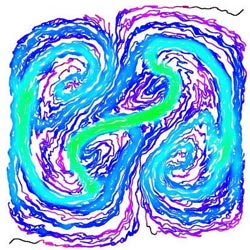Cat's eyes: Designing the perfect mixer

This is an instantaneous illustration of the lamination observed during a cat's eyes flip mixing sequence.<br><br>Credit: L.Rossi/CEA<br>
Mixing strategies are even more critical for industrial products, where every batch that is manufactured must meet the same exacting standards and yet, to manage costs, be created in the least amount of time.
In a new paper published in the journal Physics of Fluids, fluid mechanics expert Lionel Rossi, a researcher at the French Alternative Energies and Atomic Energy Commission (CEA), and his colleagues from Imperial College London describe a new recipe for industrial mixing with the potential to optimize mixers.
The process uses magnets to generate synchronized flows of jets that move in opposite directions and whose positions are slightly offset from each other. By controlling the timing of the jets and their strength and position, the researchers created a promising mixing sequence called a “cat's eyes flip flow,” named because the resulting pattern, as visualized with colored dyes added to the solution, resembles the delicate almond shape of a cat's eye. They studied the flows created by this sequence and compared them to other patterns, and found that the cat's eyes flip flows were most efficient at mixing solutions.
“The new sequence is both robust and fast, and its relative simplicity makes it transferable to mixing devices at all scales,” Rossi said. At very small scales, he noted, the sequence should help reduce mixing times and possibly even the space required for mixing. This would be of interest for lab-on-a-chip applications “that require numerous manipulations in a minimum of time and space,” Rossi said.
At larger scales, he continued, “the sequence should increase performance while reducing energy consumption,” for example by reducing the stirring of saturated regions, making the process more environmentally friendly.
Next, the researchers plan to develop tailored mixing strategies applicable to almost any mixing need, by using different sequences of synchronized flows as building blocks.
The article, “Lamination, stretching and mixing in cat's eyes flip sequences with varying periods” by Lionel Rossi, Denis Doorly and Dimitri Kustrin appears in the journal Physics of Fluids. See: http://dx.doi.org/10.1063/1.4812798
ABOUT THE JOURNAL
Physics of Fluids is devoted to the publication of original theoretical, computational, and experimental contributions to the dynamics of gases, liquids, and complex or multiphase fluids. See: http://pof.aip.org
Media Contact
More Information:
http://www.aip.orgAll latest news from the category: Physics and Astronomy
This area deals with the fundamental laws and building blocks of nature and how they interact, the properties and the behavior of matter, and research into space and time and their structures.
innovations-report provides in-depth reports and articles on subjects such as astrophysics, laser technologies, nuclear, quantum, particle and solid-state physics, nanotechnologies, planetary research and findings (Mars, Venus) and developments related to the Hubble Telescope.
Newest articles

Properties of new materials for microchips
… can now be measured well. Reseachers of Delft University of Technology demonstrated measuring performance properties of ultrathin silicon membranes. Making ever smaller and more powerful chips requires new ultrathin…

Floating solar’s potential
… to support sustainable development by addressing climate, water, and energy goals holistically. A new study published this week in Nature Energy raises the potential for floating solar photovoltaics (FPV)…

Skyrmions move at record speeds
… a step towards the computing of the future. An international research team led by scientists from the CNRS1 has discovered that the magnetic nanobubbles2 known as skyrmions can be…





















